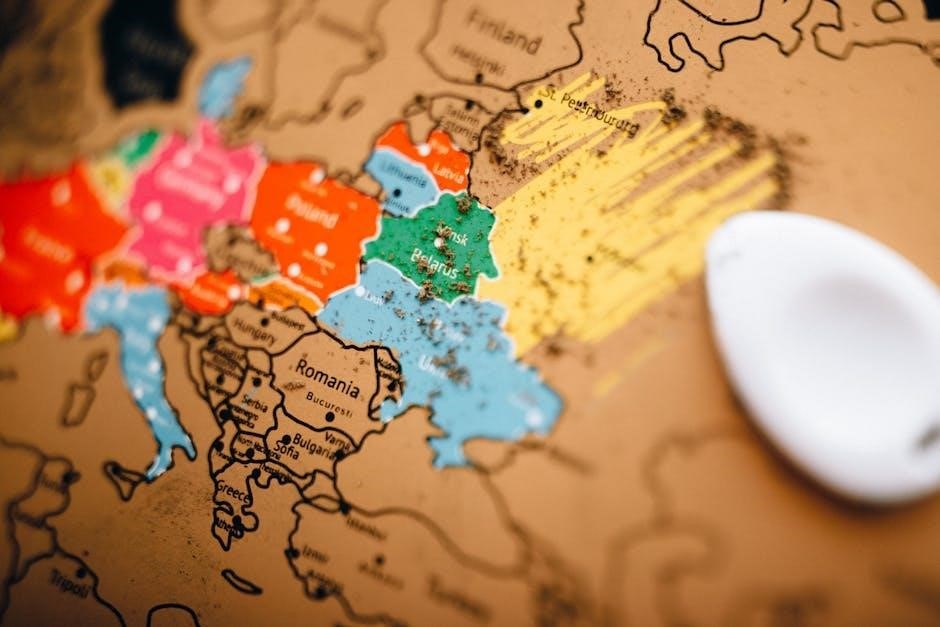
world of warcraft discipline priest guide
Discipline Priests are a unique healing specialization that combines damage dealing with proactive mitigation, excelling in both PvE and PvP through Atonement and absorption abilities.
1.1 Overview of the Discipline Priest Specialization
The Discipline Priest is a unique healing specialization that leverages the power of Atonement to heal allies through dealing damage to enemies. This spec combines elements of Holy and Shadow magic to provide a blend of proactive damage mitigation and reactive healing. Discipline Priests excel at absorbing incoming damage and enhancing group survival through powerful abilities like Power Word: Shield and Rapture. Their playstyle revolves around managing Atonement buffs on allies, which convert a portion of their damage dealt into healing. This specialization is particularly effective in both PvE and PvP content, offering a dynamic and engaging experience for players who enjoy a mix of healing and damage dealing.
1.2 Unique Playstyle and Role in PvE and PvP
Discipline Priests offer a distinctive playstyle that sets them apart from other healers. In PvE, they excel at absorbing damage and providing consistent group utility, making them invaluable for raid and dungeon content. Their ability to preemptively mitigate damage through Atonement and Power Word: Shield allows them to shine in high-pressure environments. In PvP, Discipline Priests leverage their damage-dealing capabilities to pressure enemies while maintaining strong defensive utility. This dual role requires precise timing and situational awareness, making the spec both challenging and rewarding. Their unique blend of healing and damage dealing ensures they are a versatile choice for various in-game scenarios, offering a dynamic experience in both cooperative and competitive play.
1.3 Importance of Proactive Damage Mitigation
Proactive damage mitigation is the cornerstone of a Discipline Priest’s effectiveness. By anticipating incoming damage, Priests can apply Power Word: Shield and leverage Atonement to absorb and redirect harm. This approach reduces the need for reactive healing, allowing for smoother group survival. Properly timing abilities like Rapture and Pain Suppression maximizes absorption and ensures critical moments are handled efficiently. Mastery of these mechanics not only enhances group resilience but also complements the Priest’s healing output. Proactive mitigation is essential for maintaining control in high-stress encounters, making it a defining feature of the Discipline Priest playstyle.

Talents and Builds
Talents and builds are crucial for optimizing a Discipline Priest’s performance, enabling players to balance healing, damage, and utility effectively. Proper talent selection enhances Atonement efficiency.
2.1 Best Talents for PvE Content
For PvE content, Discipline Priests should focus on talents that maximize Atonement healing and absorption. Schism and Shadow Covenant are essential for enhancing damage and healing. Contrition provides consistent mana regeneration, while Power Word: Solace adds supplementary damage and healing. Evangelism and Rapture are crucial for cooldown management, with Rapture offering significant burst healing potential. In the later rows, San’layn and Penance: Sin amplify damage output and Atonement application. These talents synergize to create a robust setup for raid and dungeon healing, ensuring optimal damage mitigation and healing efficiency. Proper talent selection is vital for excelling in PvE environments and supporting the group effectively.
2.2 Optimal Talents for PvP Encounters
In PvP, Discipline Priests benefit from talents that enhance survivability, crowd control, and burst healing. Phantasm provides excellent mobility, while Silence and Psychic Horror offer strong crowd control. Power Word: Shield and Rapture remain pivotal for absorption and burst healing. Strength of Soul reduces damage taken, making it a staple for PvP. Censure increases damage and healing during Shadow Word: Pain, while Voidbrige enhances burst potential. These talents create a balance between offensive pressure and defensive capabilities, making Discipline Priests formidable in Arena and Battlegrounds. Proper talent selection is key to dominating PvP encounters while maintaining healing and damage output.
2.3 Customizing Your Build for Different Playstyles
Discipline Priests can adapt their builds to suit various playstyles by modifying talents. For a more aggressive approach, Schism and Purify in Thought enhance damage output and Atonement efficiency. Players seeking survivability often choose Strength of Soul and Voidbrige for improved defense. Those focused on burst healing may opt for Rapture and Evangelism. Additionally, Phantasm and Psychic Horror offer mobility and crowd control, ideal for PvP. By tailoring talents to their preferred style, Priests can maximize their effectiveness in both PvE and PvP, ensuring a balanced yet specialized approach to healing and damage mitigation. This flexibility makes Discipline Priests versatile and adaptable in dynamic game environments.

Stats and Gear
Discipline Priests prioritize Haste and Mastery for enhanced healing and damage mitigation. Gear selection focuses on items that boost these stats, optimizing absorption and group support capabilities effectively.
3.1 Stat Priorities for Discipline Priests
Discipline Priests prioritize Haste to reduce spell cast times and enhance Atonement’s effectiveness. Mastery is next, as it increases damage absorption through Atonement. Critical Strike amplifies healing and damage, while Versatility boosts overall effectiveness. Intellect improves spell power, but is less impactful compared to other stats. For secondary stats, focus on gear with high Haste and Mastery. Avoid items with low Versatility. Balancing these stats ensures optimal healing, damage dealing, and absorption, making Discipline Priests versatile in both PvE and PvP. Proper stat allocation is crucial for maximizing Atonement’s potential and maintaining group survivability.
Selecting the right gear is vital for Discipline Priests to maximize healing and damage. Prioritize items with high Haste and Mastery to enhance Atonement and absorption. Critical Strike and Versatility are also valuable, increasing effectiveness in both healing and damage; Use Wowhead or Raidbots to optimize gear with simulations. Focus on obtaining high ilevel pieces, especially from raids and Mythic dungeons. Accessories and trinkets offering on-use effects can provide additional utility. Avoid low Versatility items and ensure a balanced stat distribution. Regularly update gear to match the latest content patches for optimal performance. Proper gear optimization ensures Discipline Priests can effectively manage damage and healing in both PvE and PvP scenarios. Discipline Priests balance healing and damage through Atonement, using spells like Smite and Penance to heal allies while dealing damage. Maintain Atonement on targets, leveraging Power Word: Shield and Shadow Mend for proactive mitigation. Use Evangelism and Rapture during high-damage phases to amplify healing. Always prioritize Atonement application and damage dealing to maximize effectiveness. Mastering Atonement is central to Discipline Priests, as it converts damage dealt into healing for allies. Apply Atonement through Shadow Mend or Power Word: Shield, prioritizing high-value targets. Maintain Atonement on allies during damage phases to maximize healing. Use Smite and Penance to deal consistent damage while extending Atonement durations. Balance proactive healing with damage output, ensuring Atonement remains active on multiple targets. During burst damage, use Evangelism and Rapture to amplify healing. Always monitor Atonement uptime and adjust your rotation to prevent overhealing or mana inefficiency. Properly managing Atonement and damage abilities ensures optimal healing and group survival. Balancing healing and damage dealing is crucial for Discipline Priests, as their effectiveness depends on this synergy. Use Atonement to heal allies through damage, focusing on Smite and Penance during downtime. Avoid overextending damage output, ensuring healing remains consistent. During heavy damage phases, prioritize Shadow Mend and Power Word: Shield to maintain high absorption. Use Rapture and Evangelism to amplify healing during critical moments. Monitor cooldowns and mana to sustain both roles. Proper balance ensures optimal group survival and damage contribution, making Discipline Priests versatile in both PvE and PvP. Discipline Priests rely on powerful cooldowns like Rapture and Power Word: Shield to manage absorption and group survival. Use Shadow Mend for spot healing and Pain Suppression in emergencies. Discipline Priests utilize powerful cooldowns to amplify their healing and damage absorption. Rapture is a cornerstone ability, generating a large absorb shield and resetting Power Word: Shield’s cooldown. Use it during heavy damage phases to protect your group. Evangelism enhances your Atonement healing, making it crucial for ramping up healing during intense moments. Pain Suppression reduces damage taken on a target, pairing well with Power Word: Barrier for group-wide protection. Timing these cooldowns is vital to maximize their effectiveness and ensure optimal absorption and healing output. Properly synchronizing them with damage windows ensures your group survives even the most challenging encounters. Power Word: Shield is a fundamental ability for Discipline Priests, providing a absorb barrier that mitigates incoming damage. Use it preemptively on tanks or high-damage targets to prevent health loss. Rapture amplifies this by creating a larger absorb shield and resetting Power Word: Shield’s cooldown. Timing Rapture during heavy damage phases maximizes its impact. Combine these abilities with Evangelism to enhance Atonement healing. Properly managing these tools ensures optimal damage absorption and group survival, making them indispensable in both raids and Mythic dungeons. Effective use requires anticipation of incoming damage and strategic application to maintain high levels of protection. Discipline Priests excel at proactive healing through Atonement, converting damage dealt into healing. Mastering absorption and damage reduction while balancing Atonement application ensures optimal group survival and sustained healing output. Discipline Priests thrive on proactive healing, anticipating damage through Atonement and absorption. This approach requires foresight, applying shields and Atonement before damage occurs. Reactive healing, while sometimes necessary, is less efficient for Discipline Priests, as their strength lies in mitigating harm before it impacts the group. By focusing on preemptive measures like Power Word: Shield and Rapture, Discipline Priests ensure sustained group survival. Balancing these strategies is key, as over-reliance on reactive healing can diminish overall effectiveness. Mastery of proactive techniques enhances the spec’s unique ability to manage and prevent damage. Atonement is the cornerstone of Discipline Priest group healing, converting damage dealt into healing for allies; To maximize its effectiveness, apply Atonement to multiple targets, ideally 5-10, to scale healing efficiently. Use Shadow Mend for consistent, mana-efficient Atonement application, while Power Word: Shield is best reserved for critical moments. Timing is crucial—apply Atonement before damage spikes to ensure proactive healing. Maintain Atonement uptime by weaving in Penance and Smite during downtime, ensuring continuous healing. Proper Atonement management is key to Discipline Priests’ effectiveness in both PvE and PvP, making it essential to master for optimal group survival and throughput. Discipline Priests provide exceptional group utility through absorption effects, enhancing survival. Abilities like Power Word: Barrier and Pain Suppression offer critical protection, ensuring group stability in intense encounters. Absorption abilities are the cornerstone of the Discipline Priest’s utility, significantly enhancing group survival. Power Word: Shield provides a robust protective barrier, absorbing incoming damage. When paired with Rapture, this can trigger additional healing, making it a powerful tool during high-damage phases. Additionally, Atonement allows the Priest to heal allies by dealing damage to enemies, effectively turning offensive actions into defensive support. By strategically applying these abilities, Discipline Priests can mitigate large amounts of damage, stabilize the group, and prevent potential wipes. This proactive approach to healing ensures the team remains resilient, even in the most challenging encounters. Proper timing and management of these absorption tools are crucial for maximizing their effectiveness. Pain Suppression and Power Word: Barrier are essential tools for Discipline Priests to enhance group survival. Pain Suppression reduces a target’s damage taken by 40% for 8 seconds, making it ideal for protecting tanks or vulnerable players during heavy attacks. Power Word: Barrier creates a shield, absorbing damage for all allies within its area, perfect for mitigating AoE damage in raids or dungeons. Using these abilities strategically can significantly reduce incoming damage and stabilize the group. Proper timing, such as during boss mechanics or high-damage phases, is crucial for maximizing their impact. These cooldowns are vital for maintaining control and ensuring the team’s survival in challenging encounters. Discipline Priests excel in PvE, leveraging Atonement for efficient group healing while managing damage with absorption and shields. Their unique playstyle thrives in coordinated raid environments, ensuring optimal mitigation and support through strategic ability use. Raid preparation for Discipline Priests involves optimizing talents, gear, and understanding encounter mechanics. Focus on stat priorities like Haste and Mastery to enhance healing and damage output. Analyze boss abilities to anticipate damage spikes and plan Atonement application accordingly. Utilize tools like Lorrgs to study healing trends and coordinate cooldowns with your team. Ensure proper positioning to maximize Shadow Covenant uptime, which amplifies your healing. Assign specific roles for Pain Suppression and Power Word: Barrier to mitigate high-damage phases. Practice managing your mana efficiently, especially during prolonged fights, by balancing healing and damage dealing effectively. Communication with your raid team is key to executing strategies seamlessly and achieving success in high-level content. In Mythic dungeons, Discipline Priests excel by leveraging proactive healing and damage mitigation. Focus on applying Atonement to high-damage allies and timing Rapture during heavy burst phases. Utilize Power Word: Barrier to protect the group from unavoidable damage, and employ Pain Suppression on tanks during critical moments. Optimize your stat priority, emphasizing Haste and Mastery to enhance your healing and damage output. Manage your mana carefully, as prolonged fights require balancing healing with damage dealing. Pre-position for mob packs to maximize Shadow Covenant uptime and adapt your cooldowns based on the encounter’s demands. Strong situational awareness and quick decision-making are crucial for success in Mythic dungeons. Discipline Priests excel in PvP through mana efficiency, burst damage, and defensive cooldowns. Use Power Word: Shield and Rapture to sustain allies while dealing consistent damage. In arenas, focus on dispels, silences, and crowd control to disrupt enemy healers and protect your team. In PvP, Discipline Priests rely on talents that enhance survivability and burst potential. Schism is a staple for its Shadow damage and healing boost. Assimilate is ideal for making shields undispellable, reducing damage taken. Misdirection helps manage cooldowns during high-pressure situations. For arenas, prioritize talents like Phantom Singularity for crowd control and Psyfiend to disrupt enemy healers. Pair these with Power Word: Shield and Rapture for sustained defense. Tailor your build to focus on mana efficiency and burst damage, ensuring you can adapt to both offensive and defensive playstyles. This setup makes Discipline Priests versatile and formidable in competitive PvP environments. In arenas, Discipline Priests thrive by balancing healing and damage while controlling the battlefield. Use Power Word: Shield and Rapture proactively to absorb incoming damage. Pain Suppression is crucial for saving teammates during heavy pressure. Position yourself to maximize Divine Star and Halo effectiveness, ensuring consistent healing. Coordinate with your partner to set up kills using Psychic Horror and Phantom Singularity for crowd control. Avoid overextending and focus on managing your mana to sustain through long engagements. Adapt your strategy based on the opponent’s composition, emphasizing defensive plays when necessary. Proper timing of cooldowns and spatial awareness are key to success in competitive arenas. Discipline Priests efficiently level by leveraging Atonement, converting damage into healing and maintaining mana efficiency. This unique playstyle accelerates progression while preparing for end-game challenges seamlessly. When leveling a Discipline Priest, focus on talents that enhance survivability and mana efficiency. At level 15, choose Schism to boost Shadow damage and healing. At level 30, opt for Masochism to convert damage into healing. At level 45, Contrition reduces the cost of Power Word: Shield, enhancing sustainability. At level 60, Auspicious Spirits improves damage and healing output. Use Power Word: Shield liberally to maintain Atonement on yourself and allies, and prioritize Smite for consistent damage and healing. This build ensures smooth progression while preparing you for end-game content. Transitioning from leveling to end-game content requires adjusting your playstyle to focus on optimizing Atonement and proactive healing. Ensure you have a solid understanding of your core abilities, such as Power Word: Shield and Rapture, as they become crucial in raids and Mythic dungeons. Refine your talent build to prioritize cooldowns like Evangelism and Shadow Covenant for maximum impact. Gear up by focusing on stat priorities like Haste and Mastery to enhance your healing output. Practice managing your mana and cooldowns in a group setting, as the demands of end-game content require precise timing and resource management. Adapt to the rhythm of Atonement by applying it strategically and following up with damage to maximize healing efficiency. Addons like WeakAuras and ElvUI are essential for tracking Atonement, cooldowns, and buffs. Customize your UI to display key healing indicators and absorption effects, enhancing your gameplay efficiency and awareness. Essential addons for Discipline Priests include WeakAuras for tracking Atonement and cooldowns, ElvUI for customizable UI layouts, and HealBot for efficient healing management. Grid2 enhances raid frames, while Deadly Boss Mods provides critical encounter alerts. These tools help optimize your gameplay by improving visibility of key abilities and buffs, ensuring you can react swiftly in dynamic situations. Additionally, Power Auras can monitor absorption effects like Rapture and Pain Suppression, while BigWigs offers boss fight timers and alerts. Proper addon configuration is crucial for maximizing your healing and damage output as a Discipline Priest. Setting up an optimal UI for a Discipline Priest involves carefully selecting and configuring addons to enhance healing efficiency. Start with ElvUI for a clean and customizable interface, which allows you to reorganize your action bars, unit frames, and overall layout. Pair this with Grid2 for detailed raid frames, enabling quick identification of group health and status effects. WeakAuras is indispensable for tracking Atonement, Rapture, and other critical abilities, providing visual cues to maximize your healing output. Additionally, Deadly Boss Mods offers essential alerts for boss mechanics, helping you anticipate and prepare for incoming damage. Position these elements strategically: place raid frames centrally, cooldowns near your character, and alerts in a corner to avoid screen clutter. Customize keybindings to ensure easy access to healing and damage-dealing spells. Finally, test your setup in low-pressure environments to refine it, ensuring a balance between functionality and aesthetics that complements your healing style. Common mistakes include misusing Atonement, inefficient Shadow Mend usage, and poor mana management. FAQs often address talent choices, cooldown timing, and optimizing damage-to-healing ratios for maximum effectiveness. Common questions include how to effectively manage Atonement, optimize mana usage, and balance healing with damage dealing. Many players ask about the best way to apply Atonement for maximum efficiency, especially in high-damage scenarios. Another frequent query is whether Discipline Priests are viable in modern content, with concerns arising from recent nerfs to key abilities like Rapture and Power Word: Shield. Additionally, players often seek clarification on cooldown management, particularly when to use Rapture versus Spirit Shell in different situations. Finally, there are questions about stat priorities and how to transition from leveling to end-game content without sacrificing performance. Common mistakes include inefficient Atonement application and poor cooldown management. Avoid applying too few Atonements before dealing damage, as this reduces healing potential. Overusing Power Word: Shield to apply Atonements is inefficient; prioritize Shadow Mend instead. Many players neglect to maintain Shadow Covenant uptime, which is crucial for consistent healing. Additionally, using Rapture during low damage periods can waste its potential. Ensure Atonements are applied to as many allies as possible before engaging in damage-dealing rotations. Properly timing Evangelism and Pain Suppression is also essential for maximizing group survival. Finally, avoid relying solely on reactive healing; proactive mitigation is key to Discipline Priest success. Discipline Priests offer a unique, dynamic playstyle that rewards skill and strategy. Continuous improvement through practice and adaptation is key to mastering this versatile specialization in World of Warcraft. Mastering the Discipline Priest requires dedication and adaptability. Stay updated with class changes, engage with the community, and refine your strategies; Consistent practice and analyzing performance are crucial for improvement. Utilize resources like guides and forums to deepen your understanding. Embrace challenges and learn from each raid or dungeon run. By focusing on proactive healing and optimizing your cooldowns, you’ll enhance your effectiveness. Remember, growth comes from persistence and a willingness to evolve, ensuring you remain a valuable asset to your team in World of Warcraft.3.2 Gear Selection and Optimization

Rotation and Priestly Devotion
4.1 Managing Atonement and Damage Abilities
4.2 Balancing Healing and Damage Dealing

Cooldowns and Abilities
5.1 Key Cooldowns for Maximum Impact
5.2 Effective Use of Power Word: Shield and Rapture

Healing Strategies
6.1 Proactive vs. Reactive Healing Approaches
6.2 Mastering Atonement for Group Healing

Group Utility and Support
7.1 Enhancing Group Survival with Absorption
7.2 Utilizing Pain Suppression and Power Word: Barrier

PvE Content and Raiding
8.1 Raid Preparation and Strategy
8.2 Mythic Dungeon Tips and Tricks
PvP and Arena Play
9.1 PvP Talents and Builds
9.2 Arena Strategies and Tips

Leveling and Development
10.1 Leveling Builds and Strategies
10.2 Transitioning from Leveling to End-Game Content
Addons and UI Optimization
11.1 Essential Addons for Discipline Priests
11.2 Setting Up Your UI for Effective Healing

FAQs and Common Mistakes
12.1 Frequently Asked Questions
12.2 Avoiding Common Errors in Discipline Priest Play
13.1 Final Thoughts and Continuous Improvement